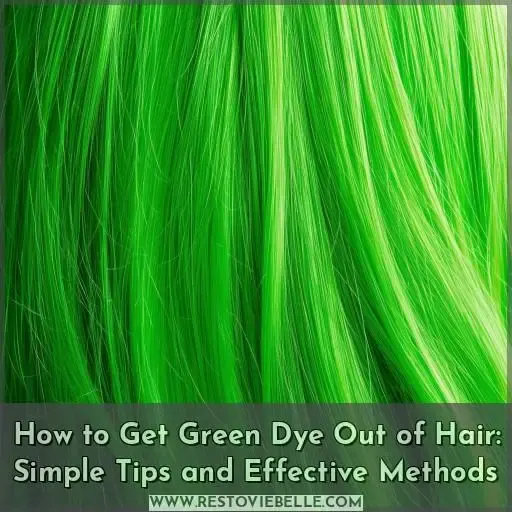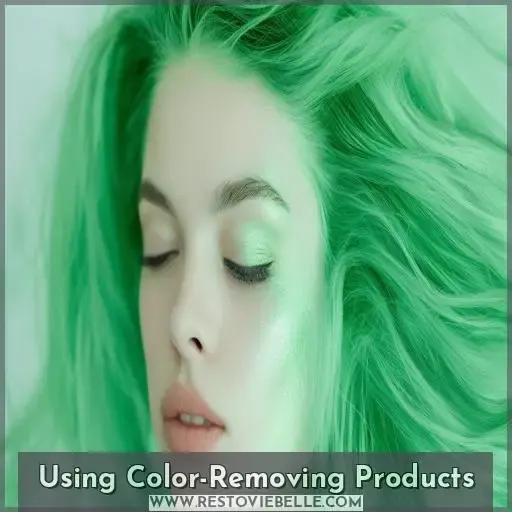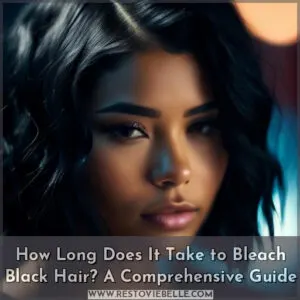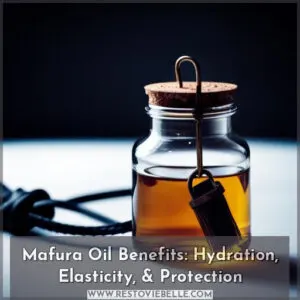This site is supported by our readers. We may earn a commission, at no cost to you, if you purchase through links.
 Getting green dye out of your hair can be frustrating, but don’t worry – there are effective solutions.
Getting green dye out of your hair can be frustrating, but don’t worry – there are effective solutions.
First, try using a clarifying or color-removing shampoo to break down the pigment.
For stubborn cases, make a baking soda paste and let it sit before rinsing.
Dish soap can also help strip the dye.
If all else fails, invest in a bleaching kit to lighten your locks.
Prevention is key, so use a barrier cream and rinse with cool water when dyeing.
With the right approach and some perseverance, you’ll have your desired shade back in no time.
Table Of Contents
Key Takeaways
- Girl, I feel your pain! Getting green dye out of your hair is like an epic battle – but don’t wave the white flag just yet. We’ve got some tricks up our sleeves to help you reclaim your luscious locks.
- First up, let’s call in the big guns: clarifying shampoos and dye removers. These bad boys are like a one-two punch, breaking down that stubborn pigment and sending it packing. Just remember, moderation is key – you don’t want to strip your strands to the bone.
- If those don’t do the trick, it’s time to bring out the big guns: baking soda and dish soap. Whip up a baking soda paste and let it work its magic, or go old-school with some good ol’ dish soap. Just be sure to give your hair a deep conditioning treatment afterwards – you don’t want it feeling like a dried-up tumbleweed.
- Prevention is always better than cure, though. Next time you’re feeling like a bold hair chameleon, protect your precious strands with a barrier cream and cool water rinses. Trust me, your future self will thank you for avoiding another green hair nightmare.
How to Get Green Dye Out of Hair?
To get green dye out of hair, you can use color-removing products like clarifying shampoos, color-stripping treatments, or bleaching kits. Another method is to wash your hair with dish soap, which can help strip the green tint, or make a baking soda paste to apply and rinse out.
Using Color-Removing Products
To remove stubborn green dye from your hair, consider using clarifying shampoos or specialized color-removing treatments. For severe cases, an at-home bleaching kit may be necessary to lift the remaining pigments.
Clarifying Shampoos
Clarifying shampoos contain gentle clarifying ingredients that remove stubborn product buildup and color residue from your strands. They’re a great option for gently fading green dye without harsh chemicals. Just be mindful that overusing clarifying shampoos can strip your hair of its natural oils and cause scalp irritation—moderation is key for healthy, color-treated locks.
Color-Removing Treatments
You could also try using dye removers or chemical color-removing treatments. These products are formulated to strip hair of artificial pigments without causing excessive damage. Always read instructions carefully, and do a strand test first. Look for reputable brands recommended by stylists. Post-treatment, deep condition to restore moisture and strength.
Bleaching Kits
Another option is using bleaching kits, but proceed with caution. It’s best to consult a professional for a hair consultation first. Bleach powder mixed with a volume developer can effectively lift color, but overtoning is common. Using a toning shampoo or corrective color after bleaching can help neutralize any lingering green tones.
Washing With Dish Soap
To remove stubborn green dye from your hair, you can wash it with dish soap. Lather the dish soap into your hair and scalp, allow it to sit for a few minutes, then rinse thoroughly.
Lather and Rinse
To lather with dish soap, wet your hair thoroughly and work in a generous amount of soap, gently massaging your scalp. Rinse thoroughly, repeating as needed until the green tint fades. Opt for a mild, sulfate-free dish soap to avoid stripping oils. Be diligent yet gentle, as overwashing can lead to dryness and damage.
Condition Thoroughly
After lathering and rinsing with dish soap, you’ll need to condition thoroughly to restore moisture. Here’s how:
- Use a deep conditioning treatment or hair mask
- Apply a leave-in conditioner or natural oils like argan or coconut oil
- Let the conditioner sit for 5-10 minutes before rinsing
Your hair may feel dry and brittle after using dish soap, so don’t skip this important step. Proper conditioning will help revive your strands.
Repeat as Needed
If the dish soap alone doesn’t remove all the green, don’t fret.
You may need to repeat the process a few times, using a mix of dish soap and conditioner to gently lift that stubborn dye.
An occasional vinegar rinse can also help strip away any lingering green.
With patience and persistence, you’ll get your locks back to their vibrant, dye-free glory.
Making a Baking Soda Paste
To make a baking soda paste for removing green dye from your hair, start by mixing baking soda with just enough water to form a spreadable paste. Once you have the right consistency, apply the paste evenly to your damp hair, making sure to coat all the green-tinted areas.
Mix Baking Soda and Water
To make a baking soda paste, you’ll need:
- 1⁄4 cup baking soda
- 2-3 tbsp water
- A small bowl for mixing
- An applicator brush (optional)
Mix the baking soda and water until you achieve a thick, spreadable paste consistency. Make sure it’s not too runny or dry for effective application.
Apply to Damp Hair
Dampen your hair with water, then scoop some of the baking soda paste onto your hands. Apply it directly to your strands, focusing on the green-tinted areas. You can target just the roots or work it through from roots to ends—it’s up to you and where that pesky green pigment has taken hold.
Let Sit for 15-20 Minutes
Let the baking soda paste sit on your hair for 15-20 minutes. This gives it time to work its magic on stubborn green dye. The longer you leave it, the more effective it’ll be, especially for thick or coarse hair.
Be careful not to let it dry completely, or you might end up with baking soda residue. For best results, cover your hair with a shower cap or towel while you wait.
Rinse and Condition
Rinse thoroughly, using cool water to remove all baking soda residue. Follow with a vinegar rinse to:
- Close the cuticle
- Add shine
- Neutralize any remaining baking soda
Alternatively, condition with a deep treatment containing lemon juice or diluted hydrogen peroxide to further lift stubborn green tones.
Preventing Green Dye in the First Place
To prevent your hair from turning green when dyeing it, apply a barrier cream or coconut oil around your hairline and ears before coloring. Also, wear a shower cap while the dye processes, and rinse with cool water afterwards to help seal the cuticles and lock in the desired shade.
Use a Barrier Cream
To prevent hair dye stains before they happen, apply a barrier cream along your hairline and ears. These create a protective film that blocks dye from penetrating the skin. Smooth a thin layer onto clean, dry areas using your fingers or a small brush. Once the dyeing process is complete, gently wipe away the cream with a damp cloth.
Wear a Shower Cap
Another preventative measure is wearing a shower cap while your hair is dyed. This creates a protective barrier, keeping the dye from transferring onto your scalp and hair. Look for:
- A snug, waterproof cap that covers your entire hairline
- Darker colors like black or navy to avoid any dye transfer
- Materials like vinyl or silicone for maximum protection
Ensuring a tight seal around your head will prevent any unwanted green tints from developing.
Rinse With Cool Water
Rinse your hair with cool water after coloring to prevent the dye from bleeding or fading. Hot water opens the cuticles, allowing more dye to wash out. For stubborn green tints, try a vinegar rinse—the acidic properties help seal the hair’s outer layer, locking in color. This simple rinsing technique minimizes damage while maximizing color retention.
Maintaining Your Desired Color
Once you’ve successfully removed the unwanted green tint from your hair, it’s important to take steps to maintain your desired color. Using color-safe shampoo and conditioner can help prevent premature fading, while limiting heat styling and getting regular trims will keep your strands healthy and vibrant.
Use Color-Safe Shampoo and Conditioner
You’ll want to invest in color-safe shampoo and conditioner to maintain your desired hue. A blue shampoo can neutralize brassiness, while a vinegar rinse removes buildup. For stubborn green tones, hydrogen peroxide, an aspirin paste, or lemon juice can gently lift pigment. With the right care, your vibrant locks will last.
Limit Heat Styling
For maintaining vibrant hair color, limit heat styling as much as possible.
Excessive heat from blow dryers, flat irons, and curling wands can cause hair cuticles to open, allowing your gorgeous hues to fade prematurely.
Instead, embrace protective air-drying styles, like braids or buns. Nourish your locks with leave-in products and natural oils.
Silk pillowcases also help minimize friction and breakage.
Get Regular Trims
You’ll also want to get regular trims every 6-8 weeks to:
- Remove split ends that make hair look dull and frizzy
- Retain length and prevent excessive breakage
- Keep your color fresh by snipping off porous, faded ends
Whether at a salon or trimming at home, regular trims are key for healthier, vibrant locks. Don’t skip this step if you want luscious, dye-treated tresses!
Frequently Asked Questions (FAQs)
How long does it take to remove green dye?
Around 40% of people struggle to fully remove green dye, even after multiple washes. It can take weeks or months of gradually fading before all traces disappear. With the right techniques and patience, you’ll get there – just embrace the vibrant journey for now!
Can green dye cause hair damage or breakage?
Yes, green dye can potentially damage hair. The harsh chemicals and frequent dyeing process can strip hair of its natural oils, leading to dryness, breakage, and split ends. Take precautions by using quality dyes, deep conditioning treatments, and minimizing dye exposure.
What are the best shampoos for color-treated hair?
Some great shampoos for colored hair are sulfate-free and contain nourishing ingredients like argan oil or keratin. Look for products labeled "color-safe" or "color-protecting" – they’ll help minimize fading and keep your hue vibrant.
Will swimming pools affect the green dye color?
Yes, swimming pools with chlorine can affect green dye color. The harsh chemicals strip hair color faster, causing the vibrant green to fade more quickly. Try using a swim cap or avoiding pool exposure to maintain your awesome green locks longer.
How often should I re-dye my hair green?
Avoid re-dyeing too often – excessive coloring damages hair. Aim for every 4-6 weeks, allowing time between touch-ups. Use high-quality dyes and deep conditioning treatments to maintain vibrant green while minimizing damage.
Conclusion
Like a masterful painter restoring a canvas, removing green dye from your hair requires patience and the right tools.
By embracing the simple yet effective methods outlined, you’ll soon display your desired shade.
With perseverance and proper techniques, you’ll effortlessly banish unwanted tones and reclaim your vibrant locks‘ allure.
Embrace the journey to restore your crowning glory.











